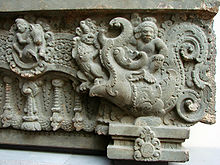
What is at the origin of the varṇa system? Can we learn something about it through Indo-European comparisons? And how was the Indo-European society organised? How can we know something about the anthropological aspect of a lost society? Is it legitimate to use for this sake indirect reflexes in its successors? Or are not we always selecting the aspects we want to focus on?
I just came back from Moscow, where I took part to the interesting workshop "Open Pages in South Asian studies", hosted by the newly funded Centre for South Asian Studies of the University for Humanities and especially by Prof. Aleksandr Aleksandrovič Stoljarov (alias Alexander Stolyarov).
One of the papers, by Sergej Kullanda, focused on Aryan Prehistory and the Culture of Hindustan. The latter term might be misleading, but Kullanda used it in a merely geographical way, and his purpose was to reconstruct something about Indo-Iranians through their Indo-European background and viceversa. Kullanda has then been kind enough to give me an article of him (Kullanda 2002) about the so-called kinship terms (such as the antecedents of "mother", "father", "brother", "daughter") in Proto-Indo European (PIE). His main point, in both the speech and the article is that we can imagine a PIE society as organized according to age-sex groups instead of genealogical groups and/or castes. Consequently terms erroneously interpreted as expressing kinship are, instead, to be interpreted as referring to age-sex groups, with the terms later identified with the meaning "mother" originally referring to a mature woman, etc.
Accordingly, Kullanda imagines the PIE distinguishing between young/mature and women/men.
Within the Indian world, varṇas could also, Kullanda continues, be interpreted as age-sex groups, with warriors corresponding to the youngest ones, vaiśyas to mature people and Brahmans to senior ones. There is a widespread consensus that varṇas were not originally fix and inherited in Vedic times. Kullanda's hypothesis, however, changes the viewpoint insofar as it links it to age, instaead as linking it to professional skills.
Kullanda did not make the following point explicit, but in order for the society to survive, the "mature" age should last much longer than the other two, for vaiśyas are much more needed than warriors, at least in peace time.
Herodotus records a Scythian story saying that the first son of the Scythian progenitor became a priest, the second an agriculture and the third (i.e., the youngest) a warrior. Dumézil also states that the second part of life is linked to the middle class and the latter with the priestly class. But, apart from IE parallels, Kullanda has some internal (i.e., Vedic) evidence in favour of his theory, insofar as Indra and the Maruts seem to be the prototypical warriors, and they are said to be "young". Further, a passage of the Śatapatha Brāhmaṇa links, according to Kullanda, the first part of life with Indra, the second with Savitṛ and the third with Varuṇa. I am not completely convinced by this point, since the context is the ritual usage for some plates (kalāpa) and the passage says that with the first one the sacrificer acquires a first lot of life and so on, while at the same time linking them to the Deities mentioned above. Hence, the link between Deities and parts of life is indirect. This does not necessarily means that Kullanda is wrong, since his 2002 article makes clear that the age-sex organisation is very ancient between IE population. Hence, no wonder if only relics of it are present in the much later texts we know of.
Of course, one might object that many Deities in many contexts are said to be young and that being a warrior necessarily entails being strong (and, hence, not old)… The fact of seeing youth as a value seems to be very much present among various traditions and is by no means a IE specificity. Consequently, the present writer would suggest to Kullanda to add to his evidences a table of absences: which Deities are never qualified as "young"? Are they linked to the vaiśyas or to the Brahmans?
On PIE, see this post. Image: a later image of a Marut from Cambodge (musée Guimet, Paris).

No comments:
Post a Comment